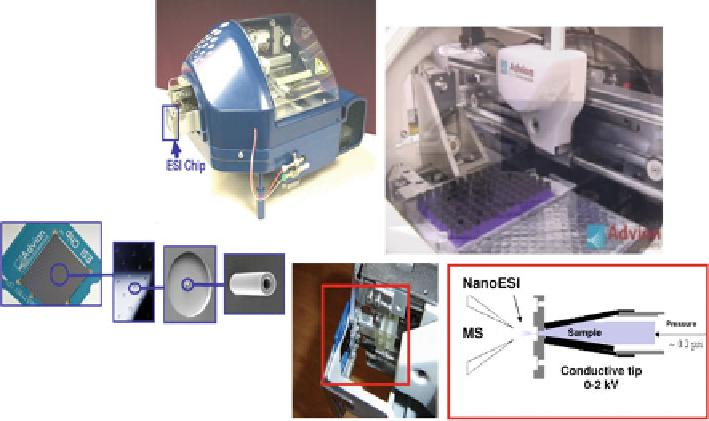Environmental Engineering Reference
In-Depth Information
Fig. 8.3 NanoMate robot with fully automated chip-based ESI (courtesy of Advion BioSciences)
diameter etched in a planar silicon chip. The chip is fabricated from a monolithic
silicon substrate using deep reactive ion etching (DRIE) and other standard
microfabrication techniques. The inert coating on the surface allows a variety of
acidic and organic compositions and concentrations to be used to promote ioniza-
tion without any degradation of the nozzle. As visible in Fig.
8.3
, a channel extends
from the nozzle through the chip. In conventional electrospray devices the electric
field is defined by the potential difference between the ESI tip (fluid potential) and
the mass spectrometer inlet. A unique feature of the ESI chip is the incorporation of
the ESI ground potential into the spray nozzle so that the electric field around the
nozzle tip is formed from the potential difference between the conductive silicon
substrate and the voltage applied to the fluid via the conductive pipette tip. In such a
configuration, the distance that defines the electric field is about 1,000 times shorter
than the one between the nozzle and mass spectrometer. Therefore, the mass
spectrometer position and voltage, though crucial for efficient ion transfer into
analyzer, do not play any role in the formation of chip electrospray, thus essentially
decoupling the ESI process from the inlet of the mass spectrometer [
26
].
These devices are amenable to high-throughput sample delivery to ESI-MS by
automated infusion and have the potential to completely replace flow-injection
analysis assays. Moreover, the technical quality of the nanosprayers obtained by
advanced silicon nanotechnology is so high, and the experiments so reproducible
that such devices have been found in some instances to give more robust and
quantitative analyses than LC- or CE-MS and to be able to suppress the need for
separation prior to MS analysis [
27
]. Due to efficient ionization properties, silicon-
based chip MS preferentially forms multiply charged ions, and the in-source

